What Is the Natural Habitat of Wild Chinchillas?
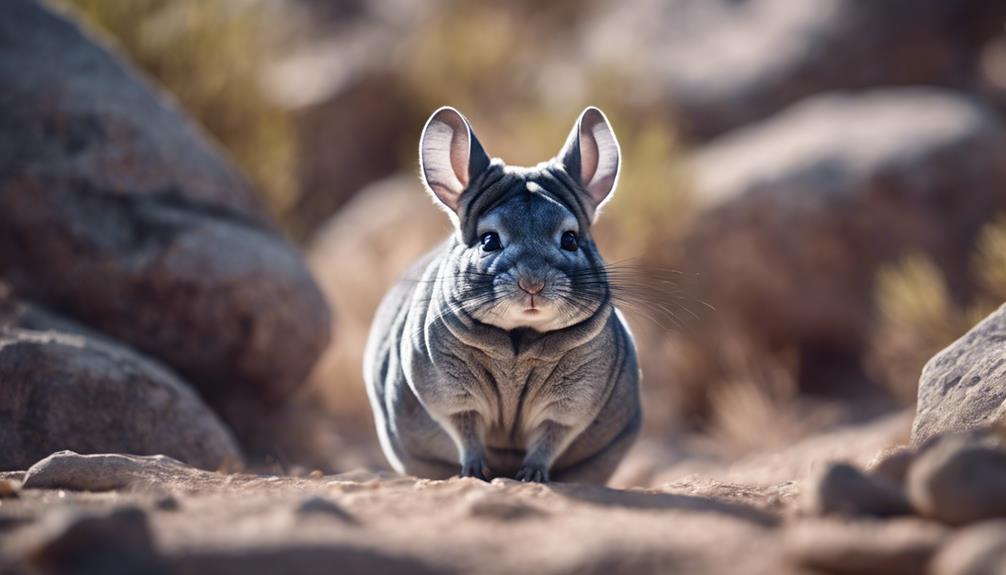
Chinchillas are small, nocturnal rodents known for their soft and dense fur, which helps them survive in their harsh environment.
They are herbivores, feeding mainly on grasses, seeds, and small plants.
Chinchillas are also known for their agility and jumping abilities, allowing them to navigate the rocky terrain with ease.
Geographic Range
The geographic range of wild chinchillas spans across the Andes Mountains in South America, specifically in regions of Chile, Peru, Argentina, and Bolivia. These elusive rodents exhibit fascinating behavior patterns within their mountainous habitat. Wild chinchillas are primarily crepuscular, meaning they're most active during dawn and dusk, which influences their foraging and social interactions.
Their behavior includes complex social structures, with individuals forming hierarchical groups to navigate their environment efficiently. Population dynamics of wild chinchillas are intricately tied to factors such as food availability, predation, and competition. The chinchilla population in the wild fluctuates in response to these variables, demonstrating resilience in adapting to their challenging habitat.
Understanding the behavior patterns and population dynamics of wild chinchillas is crucial for conservation efforts aimed at preserving their natural habitat and ensuring the long-term survival of these unique and valuable species in the Andes Mountains.
Altitude and Terrain
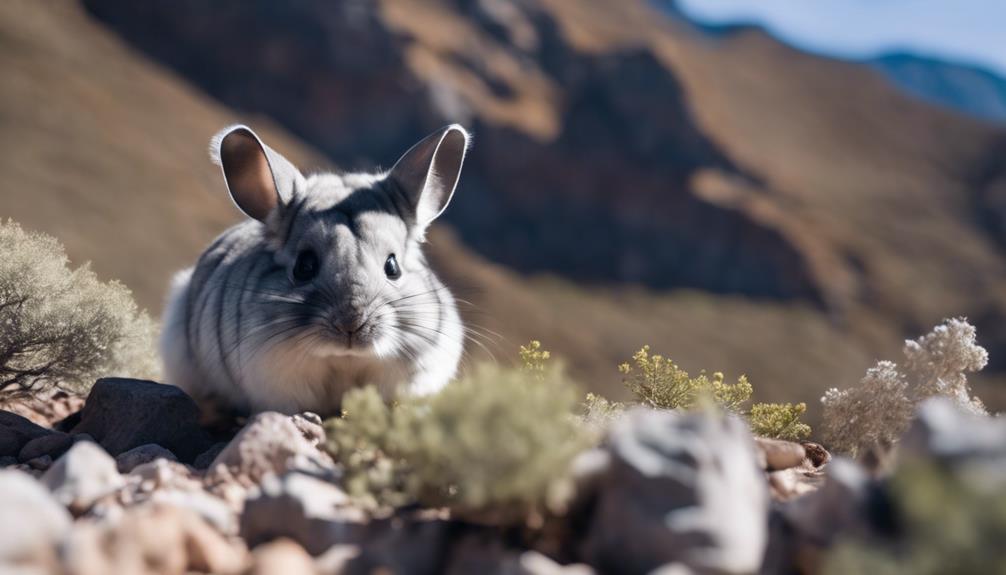
Nestled high in the rugged Andes Mountains, wild chinchillas thrive at altitudes ranging between 3,000 to 5,000 meters above sea level, navigating the challenging terrain with remarkable agility and adaptability.
- Altitude Variations: Wild chinchillas exhibit physiological adaptations to thrive in high-altitude environments, such as efficient oxygen utilization and temperature regulation.
- Population Dynamics: The population density of wild chinchillas varies across different altitude levels, with higher densities typically observed at lower altitudes due to better access to resources.
- Burrowing Habits: Chinchillas create intricate burrow systems in the rocky terrain, providing shelter from predators and extreme weather conditions.
- Ecosystem Interactions: Their burrowing activities play a crucial role in aerating the soil, influencing plant growth, and creating habitats for other species.
- Territorial Behavior: Wild chinchillas defend territories within their preferred altitude range, exhibiting social structures that help maintain population stability and resource distribution.
Vegetation and Shelter
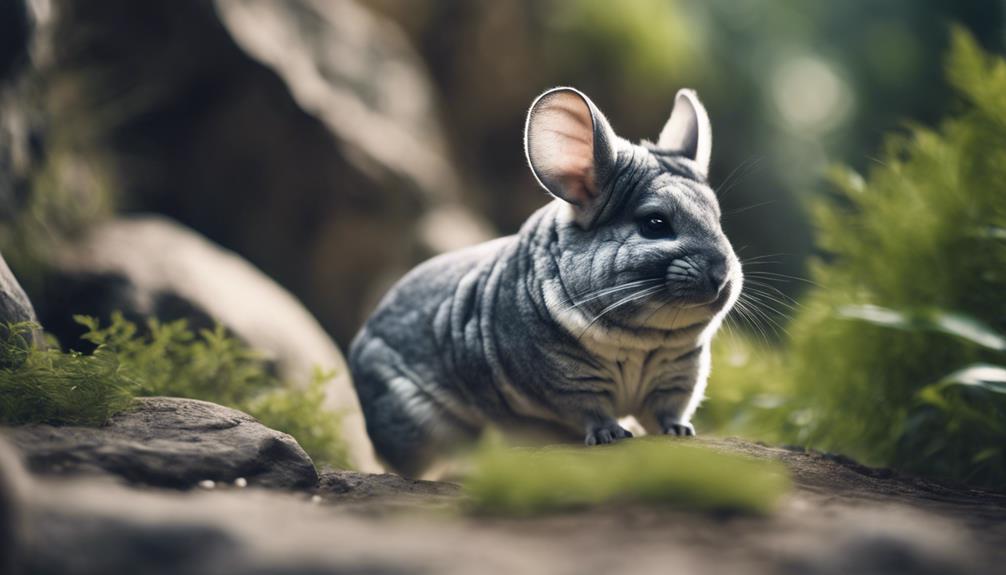
Wild chinchillas inhabit areas with a diverse range of natural vegetation cover, providing them with both food sources and shelter from predators.
These agile rodents are known for their adept climbing skills, utilizing rocky outcrops and crevices as hiding spots.
Understanding their sheltering habits is crucial to comprehending their survival strategies in their natural habitat.
Natural Vegetation Cover
Amidst the rugged terrain of the Andes Mountains, a diverse array of native vegetation provides crucial shelter and sustenance for wild chinchillas. The natural vegetation cover in the chinchilla habitat consists of:
- Grasses: Chinchillas feed on a variety of grasses rich in nutrients.
- Shrubs: They rely on shrubs for both food and shelter.
- Cacti: Chinchillas consume cacti as a source of hydration.
- Mosses and Lichens: These are essential food sources due to their high water content.
- Alpine Flowers: Chinchillas supplement their diet with the nectar and pollen from alpine flowers, adding essential nutrients.
This diverse vegetation cover not only provides food sources but also plays a vital role in ensuring water availability for the wild chinchillas.
Sheltering Habits
In the natural habitat of wild chinchillas, their sheltering habits revolve around utilizing the diverse vegetation for protection and safety. Chinchillas are known to seek refuge in rocky crevices, burrows, and dense shrubbery to shield themselves from predators and harsh weather conditions. They exhibit social interactions within their sheltering habits, often sharing burrows with family members or other chinchillas in their group. This behavior not only provides a sense of security but also fosters social bonds among the individuals. In terms of reproductive strategies, chinchillas may use these shared shelters as safe spaces for mating and raising their offspring. This communal approach to sheltering highlights the cooperative nature of chinchilla communities.
| Sheltering Habits Table | |
|---|---|
| Social Interactions | Shared burrows |
| Reproductive Strategies | Mating in shelters |
Temperature and Climate
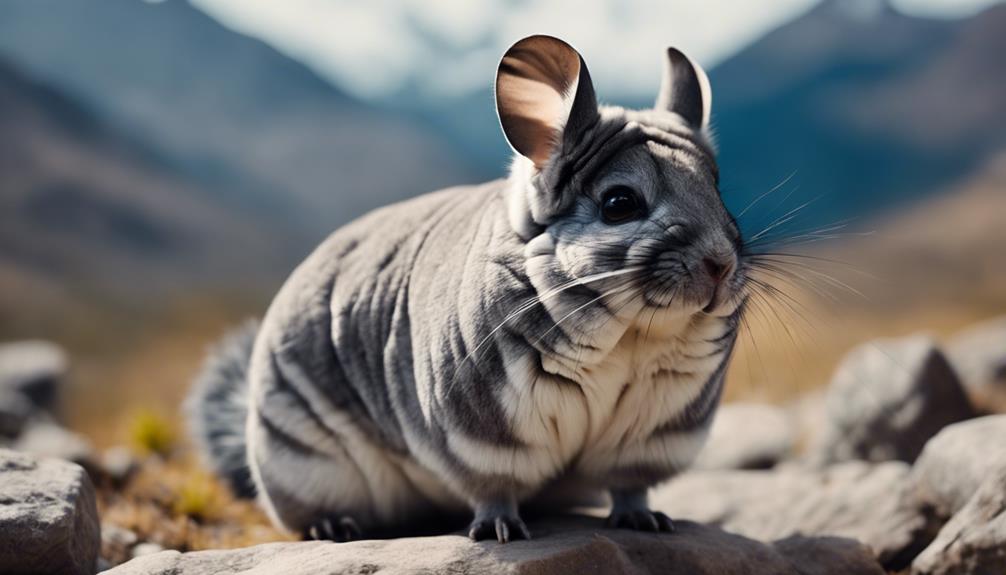
How do temperature and climate influence the natural habitat of chinchillas? Wild chinchillas have specific adaptations to thrive in their environment, utilizing various techniques to regulate their body temperature and survive in diverse climatic conditions.
- Hibernation Patterns: Chinchillas have unique hibernation patterns, enabling them to conserve energy during colder months.
- Behavioral Adaptations: They exhibit behaviors such as burrowing underground to escape extreme temperatures.
- Thermoregulation Techniques: Chinchillas regulate their body temperature through methods like dust bathing and seeking shade.
- Environmental Factors: Factors like altitude and vegetation cover play a crucial role in determining their habitat suitability.
- Climate Impact: Extreme temperatures can impact chinchillas' reproductive cycles and overall health, emphasizing the importance of climate moderation in their habitat.
Understanding how chinchillas interact with their environment sheds light on the delicate balance required to protect these fascinating creatures and ensure their continued survival in the wild.
Predators and Threats
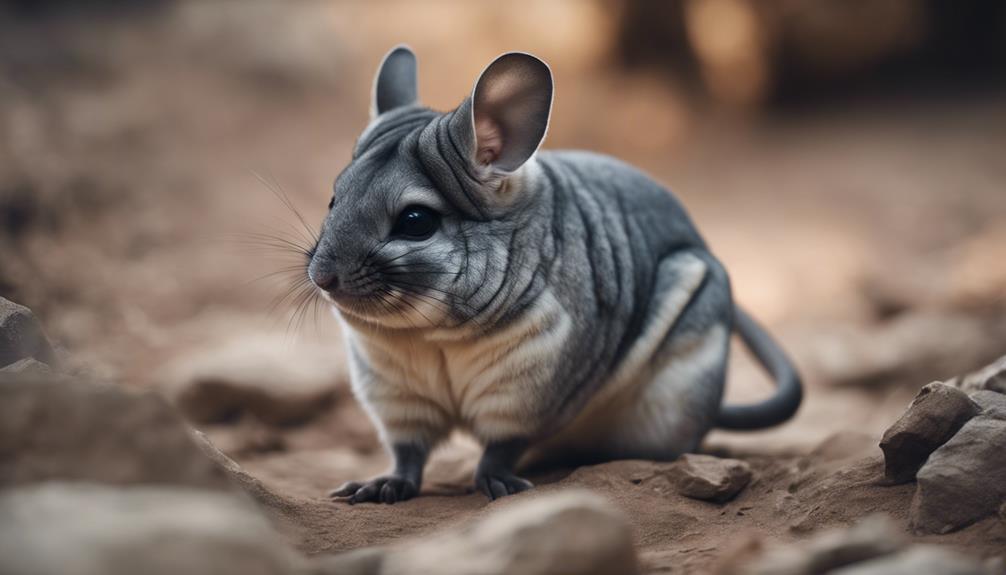
Temperature and climate significantly influence the natural habitat of wild chinchillas, shaping their adaptations and survival strategies; however, they also face various predators and threats in their environment. Wild chinchillas exhibit behaviors that help them evade predators, such as their ability to freeze in place when sensing danger, relying on their excellent camouflage in rocky terrains to avoid detection. Some common predators of wild chinchillas include birds of prey like owls and foxes, which are skilled hunters. In terms of threats, habitat destruction due to human activities like mining and agriculture poses a significant risk to wild chinchilla populations, leading to habitat fragmentation and loss. Conservation efforts are crucial to protect these small mammals from extinction, focusing on preserving their natural habitats and raising awareness about the importance of safeguarding their ecosystems. The table below summarizes the predators and threats faced by wild chinchillas:
| Predators | Behavior | Threats |
|---|---|---|
| Birds of Prey | Freeze in place | Habitat Loss |
| Foxes | Camouflage in rocky terrains | Fragmentation |
| Alarm calls to warn others | Human activities |
Nesting and Burrowing
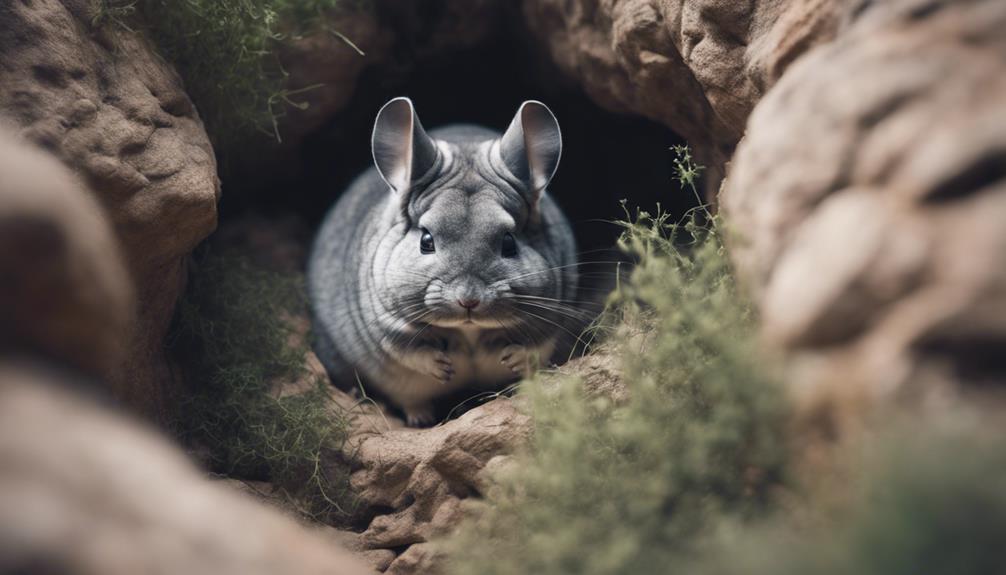
Wild chinchillas display intricate nesting behaviors. They meticulously arrange natural materials to create cozy, secure homes. Their burrowing habits are essential for protection from predators and temperature regulation. Burrows serve as safe havens for rest and reproduction.
Observations indicate that chinchillas prefer using soft grasses, twigs, and fur to construct their nests. This showcases their resourcefulness in adapting to their environment.
Nesting Behavior Overview
The nesting behavior of wild chinchillas involves intricate construction of burrows in their natural habitat. These burrows serve as safe havens for chinchillas to rest, breed, and raise their young.
- Social Interactions: Chinchillas exhibit social behavior within their burrows, often sharing nesting spaces with family members or forming communal nesting areas.
- Breeding: Burrows play a crucial role in the breeding process, providing a secluded environment for mating and birthing.
- Reproductive Cycles: Female chinchillas prepare their burrows for giving birth, lining them with soft materials for the comfort of their offspring.
- Grooming Habits: Chinchillas groom themselves frequently within their burrows, maintaining their fur and hygiene.
- Protection: Burrows offer protection from predators, harsh weather conditions, and other potential threats.
Burrowing Habits and Needs
In their natural habitat, chinchillas exhibit meticulous burrowing habits essential for their survival and well-being. These small rodents are known for their intricate burrow systems, which serve various purposes such as shelter, protection from predators, and regulating body temperature.
Chinchillas engage in extensive digging activities, creating complex underground tunnels with multiple entrances and chambers. Their burrowing behavior also aids in maintaining physical and mental stimulation, promoting overall health and reducing stress.
Environmental requirements for chinchilla burrows include well-drained soil to prevent flooding, adequate ventilation to ensure air circulation, and suitable depth to accommodate the chinchilla's natural instincts. Understanding and respecting these burrowing needs are crucial for providing a conducive habitat for wild chinchillas to thrive in their natural environment.
Natural Materials Used
Utilizing a variety of natural materials found in their environment, chinchillas skillfully construct their nests and burrows with precision and efficiency. Chinchillas show remarkable adaptability in their choice of nesting materials. Here are some of the natural materials they commonly use:
- Soft grasses and hay
- Fine twigs and sticks
- Feathers and fur for added insulation
- Moss and lichens for camouflage
- Soft soil or sand for burrow lining
These materials not only provide comfort and warmth but also help chinchillas camouflage their nests from potential predators. By integrating these elements into their habitats, chinchillas mitigate predation risks and create safe havens for their young, showcasing their instinctual prowess in responding to grazing habits and environmental challenges.
Adaptations and Survival

Camouflaged by its dense fur and agile movements, the wild chinchilla blends seamlessly into its rocky habitat, evading predators with remarkable efficiency. These small rodents exhibit distinctive behavioral patterns that aid in their survival. Chinchillas are crepuscular, meaning they're most active during dawn and dusk, which allows them to forage for food while minimizing the risk of encountering predators. Their keen sense of hearing and quick reflexes also contribute to predator avoidance.
In terms of diet preferences, wild chinchillas are herbivores, primarily consuming grasses, leaves, and seeds. They've adapted to extract moisture from their food, reducing their reliance on water sources, which can be scarce in their arid habitat. Additionally, their efficient digestive systems enable them to extract maximum nutrients from their fibrous diet. These adaptations have contributed to the chinchilla's survival in the harsh terrain they call home, showcasing nature's remarkable ability to optimize creatures for their environments.
Frequently Asked Questions
Are Wild Chinchillas Endangered or Threatened by Human Activities?
Conservation efforts aim to protect wild chinchillas from human impact. Population dynamics of these creatures are threatened by habitat loss. Efforts to preserve their natural environments are crucial to prevent endangerment and ensure their survival.
How Do Wild Chinchillas Communicate With Each Other in Their Natural Habitat?
In the wild, chinchillas communicate through a vibrant symphony of vocal cues and intricate body language, like a lively dance of whispers. Scent marking and grooming further enhance their social interactions, creating a rich tapestry of connection.
Do Wild Chinchillas Exhibit Any Specific Behaviors or Social Structures in the Wild?
Wild chinchillas in the wild exhibit fascinating social interactions and group dynamics. Their foraging behavior often leads to territorial disputes among them. These behaviors are crucial for their survival and adaptation to their natural environment.
What Is the Average Lifespan of a Wild Chinchilla in Its Natural Habitat?
In the wild, the average lifespan of a chinchilla is around 10 years. They face threats from predators like foxes and birds of prey. To survive, they rely on their keen senses and adaptations to environmental factors.
How Do Wild Chinchillas Find Mates and Reproduce in the Wild?
Wild chinchillas navigate their social dynamics with intricate mating rituals to find mates. Through these behaviors, they ensure reproductive success and maintain their breeding patterns. Their interactions are vital for sustaining their population in the wild.











